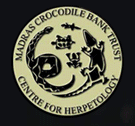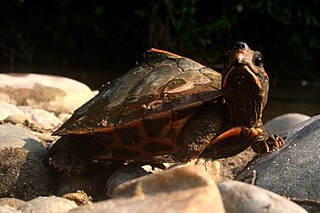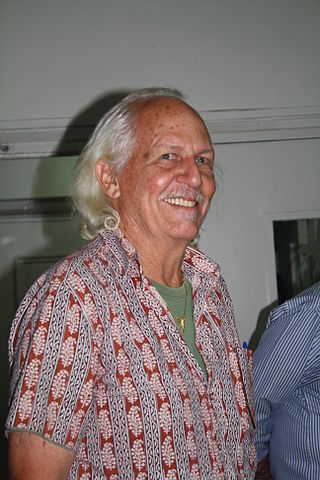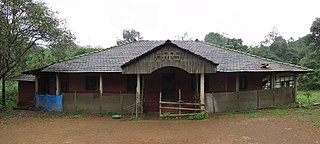
The Madras Crocodile Bank Trust and Centre for Herpetology (MCBT) is a reptile zoo and herpetology research station, located 40 kilometres (25 mi) south of the city of Chennai, in state of Tamil Nadu, India. The centre is both a registered trust and a recognized zoo under the Wildlife (Protection) Act, 1972 and comes under the purview of the Central Zoo Authority, Ministry of Environment, Forest and Climate Change, Government of India. It was established with the aim of saving three Indian endangered species of crocodile—the marsh or mugger crocodile, the saltwater crocodile, and the gharial, which at the time of founding of the trust were all nearing extinction.

Heosemys is a genus of freshwater turtles in the family Geoemydidae. The genus Heosemys was split out of the related genus Geoemyda by McDowell in 1964.
The flora and fauna of Chennai are the plants and animals in Chennai, India.

The eastern long-necked turtle is an east Australian species of snake-necked turtle that inhabits a wide variety of water bodies and is an opportunistic feeder. It is a side-necked turtle (Pleurodira), meaning that it bends its head sideways into its shell rather than pulling it directly back.

National Chambal Sanctuary, also called the National Chambal Gharial Wildlife Sanctuary, is a 5,400 km2 (2,100 sq mi) tri-state protected area in northern India for the protection of the Critically Endangered gharial, the red-crowned roof turtle and the Endangered Ganges river dolphin. Located on the Chambal River near the tripoint of Rajasthan, Madhya Pradesh and Uttar Pradesh, it was first declared in Madhya Pradesh in 1978, and now constitutes a long narrow eco-reserve co-administered by the three states. Within the sanctuary, the pristine Chambal River cuts through mazes of ravines and hills with many sandy beaches.

The Indian flapshell turtle is a freshwater species of turtle found in South Asia. The "flap-shelled" name stems from the presence of femoral flaps located on the plastron. These flaps of skin cover the limbs when they retract into the shell. It is unclear what protection the flaps offer against predators. Indian flapshell turtles are widespread and common in the South Asian provinces. It is morphologically an evolutionary link between the softshell and hardshell aquatic turtles. Exploitation for profit and habitat change are threats to their survival.

The northern river terrapin is a species of riverine turtle native to Southeast Asia. It has been classified as Critically Endangered on the IUCN Red List and considered extinct in much of its former range; as of 2018, the population in the wild was estimated at 100 mature individuals.

The Cochin forest cane turtle, also known as Kavalai forest turtle, forest cane turtle or simply cane turtle, is a rare turtle from the Western Ghats of India. Described in 1912, its type locality is given as "Near Kavalai in the Cochin State Forests, inhabiting dense forest, at an elevation of about 1500 feet above sea level". Only two specimens were found at that time, and no scientist saw this turtle for the next 70 years. It was rediscovered in 1982, and since then a number of specimens have been found and some studies have been conducted about its phylogeny and ecology.

The red-crowned roofed turtle or Bengal roof turtle is a species of freshwater turtle endemic to South Asia. It was the type species of its former genus Kachuga. Females can grow to a shell length of 56 cm (22 in) and weigh 25 kilograms (55 lb), but males are considerably smaller. The turtles like to bask in the sun on land. In the breeding season, the heads and necks of male turtles exhibit bright red, yellow and blue coloration. The females excavate nests in which they lay clutches of up to thirty eggs.

The Assam roofed turtle or Sylhet roofed turtle is a turtle species of the family Geoemydidae found in the Brahmaputra-Meghna drainage in India (Assam) and parts of eastern Bangladesh. It was formerly placed in the genus Batagur and the defunct genus Kachuga.

Romulus Earl Whitaker is an American-born Indian herpetologist, wildlife conservationist, and founder of the Madras Snake Park, the Andaman and Nicobar Environment Trust (ANET), and the Madras Crocodile Bank Trust. In 2008, Whitaker was selected as an associate laureate in the 2008 Rolex Awards for Enterprise for his efforts to create a network of rainforest research stations throughout India. In 2005, he was a winner of a Whitley Award for outstanding leadership in nature conservation. He used this award to found the Agumbe Rainforest Research Station in Karnataka, for the study of king cobras and their habitat.

The New Guinea snake-necked turtle is a species of turtle in the family Chelidae. The species is found almost exclusively within Western Province, Papua New Guinea.
Reimann's snake-necked turtle is a species of turtle in the family Chelidae. The species is endemic to Oceania and Southeast Asia.

The Amaravathi Dam is a dam constructed across the Amaravathi River. It is located at Amaravathinagar, 25 kilometres (16 mi) south of Udumalpet on SH 17 in the Indira Gandhi Wildlife Sanctuary, Tirupur district in the Indian state of Tamil Nadu. The associated Amaravathi Reservoir is 9.31 square kilometres (3.59 sq mi) in area and 33.53 metres (110.0 ft) deep. The dam was built primarily for irrigation and flood control and now also has four megawatts of electrical generating capacity installed. It is notable for the significant population of mugger crocodiles living in its reservoir and catchment basin.

The Agumbe Rainforest Research Station (ARRS) is a field based conservation and research organisation situated inside the Agumbe Reserved Forest at Agumbe in the central Western Ghats of southern India. The Agumbe Reserved Forests receives an annual rainfall in excess of 7,000 mm (280 in) and is at an elevation of about 823 m (2,700 ft) above sea level. It forms a part of the Malnad-Kodagu corridor, which also includes the Someshwara, Mookambika, Bhadra, and Sharavati Wildlife Sanctuaries, Kudremukh National Park, and various other forest tracts and reserve forests around Kundapur, Shankaranarayana, Hosanagara, Sringeri, and Thirthahalli.

Chelodina (Chelydera) burrungandjii, the sandstone snake-necked turtle or Arnhem Land long-necked turtle, is a medium-sized turtle reaching carapace lengths of 316 mm. The species is found in the sandstone plateaus and escarpments and the plunge pools of Arnhem Land of the Northern Territory. The species had been long recognised as valid. However, it had been difficult to research due to the remoteness of its habitat. Efforts to breed this species in captivity had been largely unsuccessful, until National Aquarium Herpetologist Matthew Benedict lead a successful breeding project in 2021. The species occurs in proximity to Chelodina rugosa, to which it is closely related. For the most part the two species are parapatric in distribution. However, they do come together in limited locations such as plunge pools at the base of the escarpments. In these areas there is hybridization between the species.
The Chennai Snake Park, officially the Chennai Snake Park Trust, is a not-for-profit NGO constituted in 1972 by herpetologist Romulus Whitaker and is India's first reptile park. Also known as the Guindy Snake Park, it is located next to the Children's Park in the Guindy National Park campus. Located on the former home of the Madras Crocodile Bank Trust, the park is home to a wide range of snakes such as adders, pythons, vipers, cobras and other reptiles. The park gained statutory recognition as a medium zoo from the Central Zoo Authority in 1995.
John L. Behler was an American naturalist, herpetologist, author, and activist known for his work in conserving endangered species of turtles, snakes, and other reptiles. He served as curator of herpetology at the Bronx Zoo, part of the Wildlife Conservation Society from 1976 to 2006. He co-chaired the IUCN Tortoise and Freshwater Turtle Specialist Group, and was a founding member of the Turtle Survival Alliance, which co-present the Behler Turtle Conservation Award with the Turtle Conservancy and Turtle Conservation Fund. The Behler Turtle Conservation Award is a major annual award to honor leadership in the field of freshwater turtle and tortoise conservation. The Turtle Conservancy named its captive breeding center, the Behler Chelonian Center, in his honor.
Shekar Dattatri is an Indian herpetologist and wildlife filmmaker from Chennai, Tamil Nadu.

Scott A. Thomson is an Australian herpetologist, paleontologist, and taxonomist, specialising in turtles of the family Chelidae.














